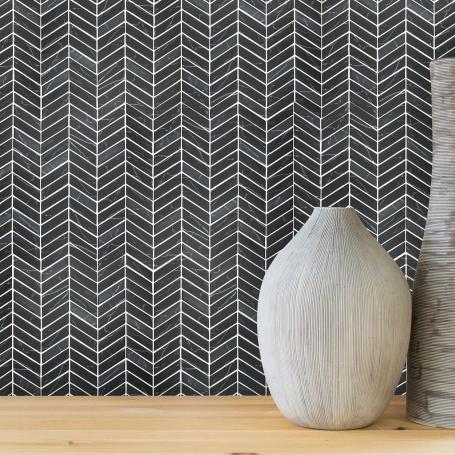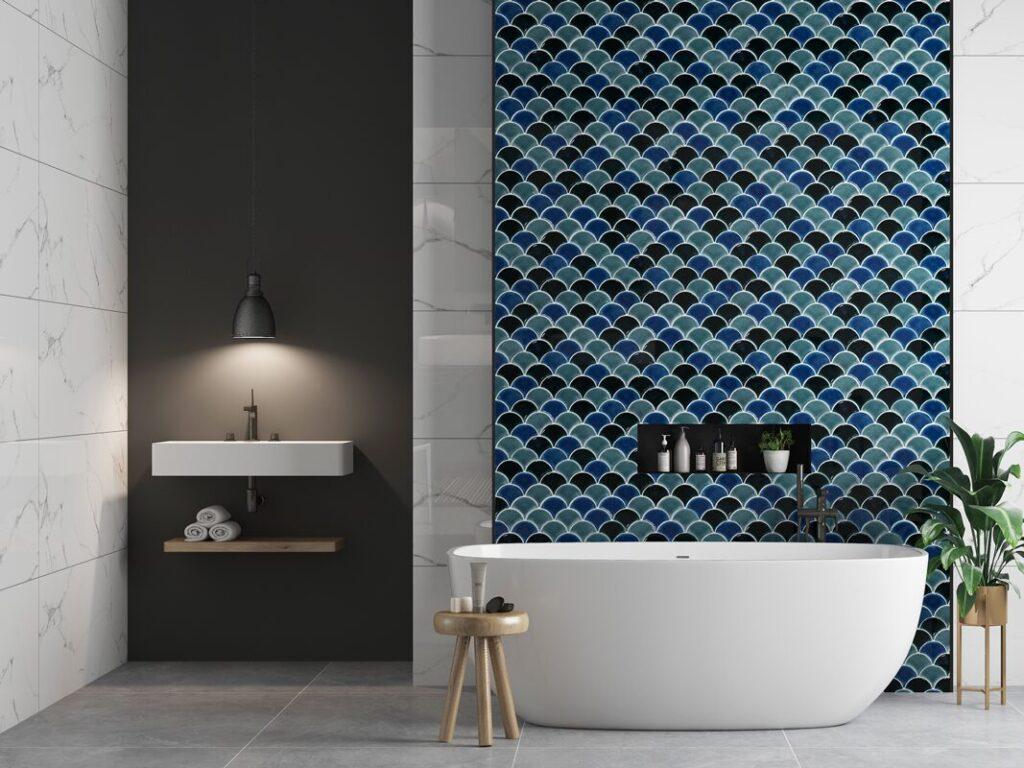
7 Trendy Tile Patterns to Elevate Your Home from Floor to Ceiling
August 15, 2024
Tiles have long been a staple in home design, offering durability, easy maintenance, and endless aesthetic possibilities. In recent years, homeowners and designers have moved beyond basic tile layouts to embrace more intricate and eye-catching tile patterns. These patterns can transform a space, adding visual interest and personality to any room. In this comprehensive guide, we’ll explore some of the most popular tile patterns trending today and discuss where and how to use them in your home. We’ll also explore the types of tiles best suited for each unique design, helping you make informed decisions for your next renovation or design project.
1. Chevron Pattern:

The chevron pattern has surged in popularity, bringing a sense of movement and sophistication to spaces. This V-shaped pattern is often confused with herringbone but is distinguished by its continuous zigzag design.
Where to use:
- Kitchen backsplashes
- Bathroom walls
- Entryway floors
- Fireplace surrounds
Suitable tile types:
- Porcelain or ceramic rectangular tiles
- Natural stone tiles (marble, limestone)
- Glass tiles for a modern look
- Wood-look tiles for a rustic touch
The chevron pattern works well with both large and small tiles, though longer tiles tend to create a more dramatic effect. For a subtle look, choose tiles in similar shades; for bold impact, opt for contrasting colors or materials.
2. Herringbone Pattern:

Herringbone, a classic pattern reminiscent of fish bones, has made a strong comeback in contemporary design. It’s similar to chevron but creates a broken zigzag effect, offering a timeless yet trendy appeal.
Where to use:
- Wood-look tile floors
- Shower walls
- Kitchen backsplashes
- Accent walls in living spaces
Suitable tile types:
- Rectangular porcelain or ceramic tiles
- Natural stone tiles (travertine, slate)
- Luxury vinyl tiles (LVT)
- Elongated subway tiles
This herringbone pattern is versatile and can be laid at a 45-degree angle or even a 90-degree angle for varied effects. It works particularly well with wood-look tiles, creating the appearance of a classic wood floor with the durability of tile.
3. Vertical Subway Tile:

While traditional horizontal or brick pattern remain popular, the vertical arrangement of subway tiles has gained traction as a fresh alternative. This simple rotation of the rectangle tiles creates a modern, elongating effect that can dramatically alter the feel of a space.
Where to use:
- Bathroom walls
- Kitchen backsplashes
- Shower enclosures
- Small spaces like powder rooms
Suitable tile types:
- Classic ceramic subway tiles
- Glass subway tiles for added shine
- Large-format porcelain tiles for a contemporary look
- Handmade ceramic tiles for texture and character
This basic pattern is especially effective in rooms with low ceilings, as they create an illusion of height. They also work well in narrow spaces such as showers, making them appear wider. For added interest, consider eliminating grout lines with seamless tile or mixing tile sizes within the vertical layout.
4. Fan Mosaic Pattern:

The fan mosaic, also known as fish scale or scallop pattern, brings a touch of whimsy and elegance to any space. This pattern features overlapping arc shapes that resemble fish scales or fan blades.
Where to use:
- Bathroom floors and walls
- Kitchen backsplashes
- Pool areas
- Accent walls in living rooms or bedrooms
Suitable tile types:
- Ceramic or porcelain mosaic tiles
- Glass tiles for a shimmering effect
- Natural stone mosaics (marble, travertine)
- Penny tiles arranged in a fan pattern
Fan mosaic patterns work beautifully in spaces where you want to add texture and visual interest without overwhelming the design. They’re particularly striking in bathrooms, where they can evoke a mermaid-inspired or art deco aesthetic. When using this pattern, consider the scale of the tiles in relation to the room size – smaller scales work well in compact areas like backsplashes, while larger scales can make a bold statement in more spacious rooms as floor tile patterns.
5. Basketweave Pattern:

The basketweave pattern is a classic design that’s seeing a resurgence in modern homes. It consists of rectangular tiles arranged to mimic the appearance of interwoven strands in a basket.
Where to use:
- Bathroom floors
- Laundry rooms
- Mudroom floors
- Kitchen backsplashes
Suitable tile types:
- Porcelain or ceramic tiles
- Natural stone (marble, travertine)
- Luxury vinyl tiles
- Combination of matte and glossy finish tiles for contrast
Basketweave patterns add texture and interest without being overly busy. They work particularly well in traditional or transitional style homes but can also add a touch of classic elegance to modern spaces. For a timeless look, opt for a black and white color scheme.
6. Hexagon Tiles:

Hexagon tiles have become increasingly popular, offering a modern twist on traditional tile shapes. They can be arranged in various geometric patterns, from uniform layouts to creative color gradients.
Where to use:
- Bathroom floors and walls
- Kitchen backsplashes
- Entryway floors
- Outdoor patios
Suitable tile types:
- Ceramic or porcelain tiles
- Natural stone hexagons
- Cement tiles for a vintage look
- Glass tiles for accent areas
Hexagon tiles are versatile and can create different effects depending on their size and arrangement. Large hexagons make a bold statement, while smaller ones can create intricate patterns. They’re particularly effective when used to create a focal point or to zone areas in open-plan spaces.
7. Grid Pattern:
The grid pattern, while simple, remains a popular choice for its clean lines and versatility. It involves laying square tiles in a straight pattern, creating a uniform, grid-like appearance.
Where to use:
- Kitchen and bathroom floors
- Shower walls
- Outdoor spaces
- Large open areas
Suitable tile types:
- Large-format porcelain tiles
- Natural stone squares
- Ceramic tiles
- Cement tiles for a vintage look
Grid patterns work well with both large and small tiles. Large-format floor tiles can make a space feel larger and more open, while smaller tiles can create a more intricate look. For added interest, consider using contrasting grout colors or mixing tiles of different textures within the grid.
Try a Different Tile Pattern with Your Next Project
The world of tile patterns offers endless possibilities for personalizing your home. From the classic elegance of herringbone to the modern appeal of vertical subway tiles, there’s a creative pattern to suit every style and space. When choosing a tile pattern, consider not only the aesthetic appeal but also the practical aspects of different materials such as maintenance, durability, and suitability for the specific area.
Don’t be afraid to mix and match custom tile patterns within your home, but do so thoughtfully to maintain a cohesive overall design. Consider using different patterns in adjacent rooms to create distinct zones while maintaining flow.
Lastly, while trends come and go, the best tile pattern for your home is ultimately the one that resonates with your personal style and meets your practical needs. Whether you opt for the timeless appeal of a classic design or the bold statement of a custom pattern, thoughtfully chosen and well-executed tile patterns can elevate your home’s style and create spaces that you’ll love for years to come.